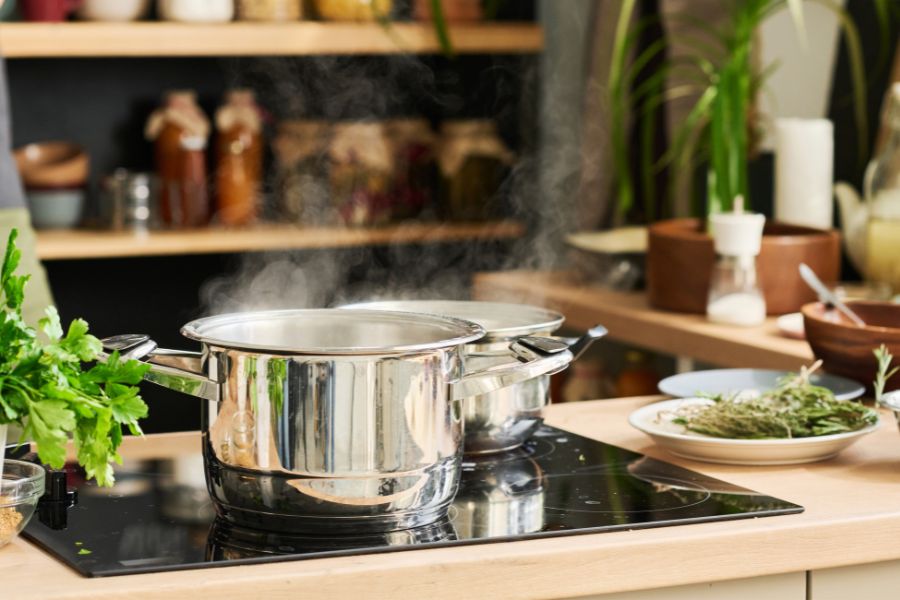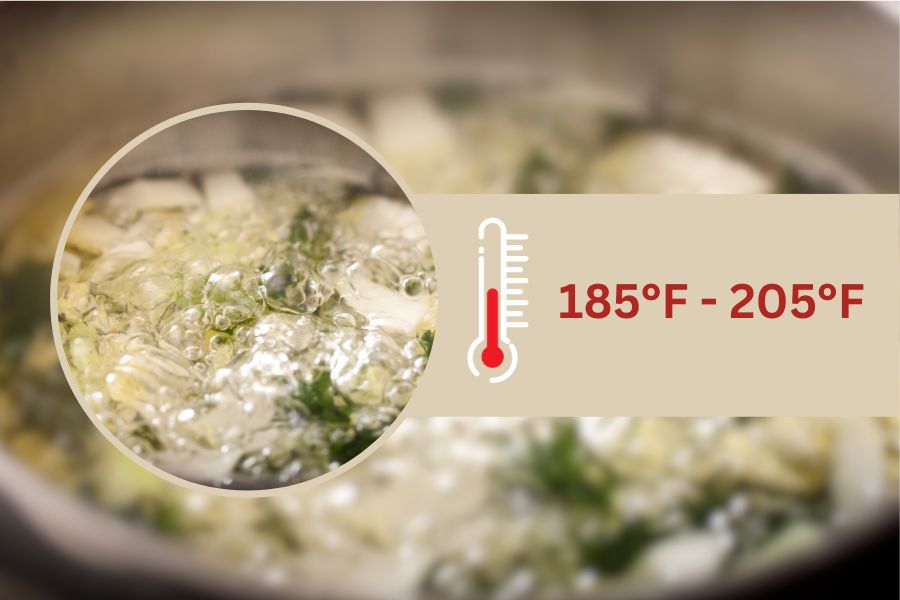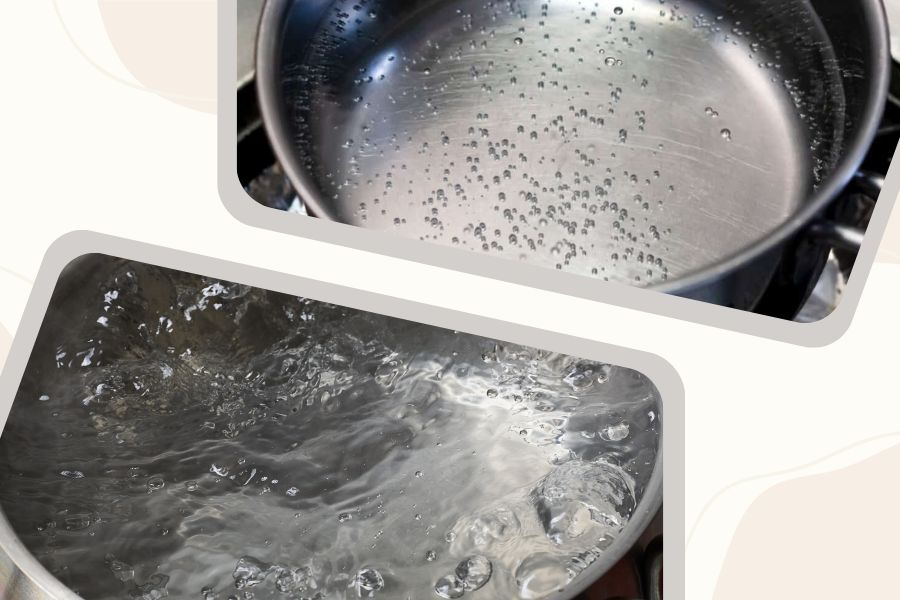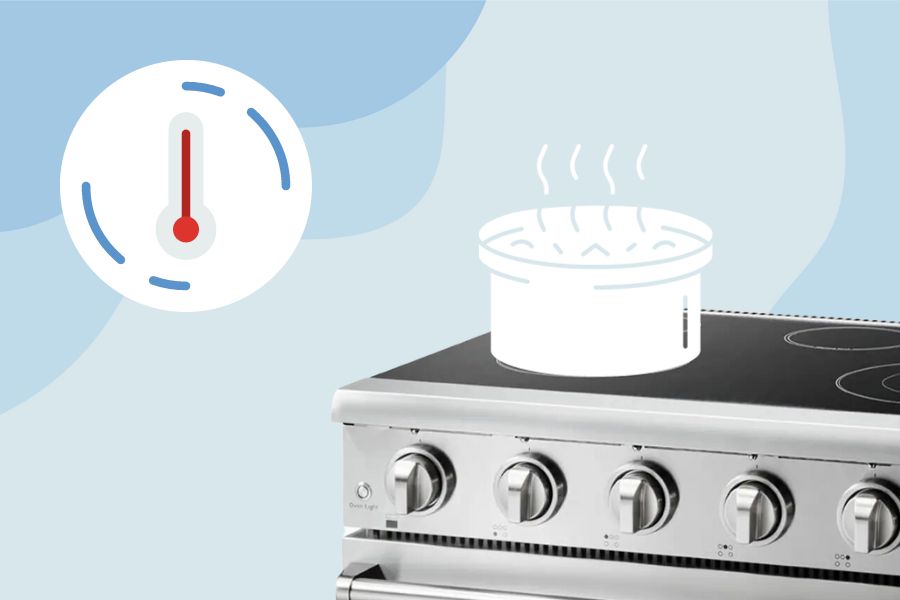Simmering is a great choice for any culinary endeavor, including stocks, soups, or starchy items like potatoes, pasta, and legumes. Although it’s only a little below boiling, the notch that keeps food soft and tender allows for more flavor and mash-ups. You can create excellent soups and stews by mastering the art of simmering and it’s essential to know what the simmer temperature is on electric stove.
In this article, we will explain how to identify the simmering temperature on a stove and other helpful information about this cooking method.
What Is Simmering on an Electric Stove?

Simmering allows you to cook food slowly and gently. It is one of the most basic methods of moist heat cooking. It uses the heat from the liquid to cook food. Simmering is less intense than boiling because there are fewer bubbles and less agitation. However, it allows the flavors to mix.
Simmering is gentler than boiling but more aggressive than poaching. Simmering is the act of cooking liquids or just boiling them. It is a bit more complex than boiling because it requires careful monitoring.
The simmering method uses moderate heat to soften food and slowly combine seasonings. This is often used to make soups, stews, and slow-cooked meat. A liquid simmered at 212°F (or less) is considered boiling. The temperature range for simmering liquids is 185°F to 205°F.
Also Read: What Does Simmer Look Like?
What Temperature Is Simmer on Electric Stove?

What Is Simmer on Stove? Most stoves don’t indicate a simmer setting. This is why knowing when a dish is simmering, boiling, or poaching is essential.
You use knobs to adjust the cooking temperature. However, the number of knobs varies from stove to stove. Some stoves have knobs that can be adjusted from 1-6 and 1-4-9 to 1-3-10, while others have knobs between 1-6 and 1-3.
The lowest heat setting is 1. This is ideal for poaching dishes.
6-9 or 10 are the highest heat settings, depending on your stove type.
The setting for simmering should be the medium-low number of each knob and should work perfectly for simmering. The medium-low heat setting for knobs with numbers 1-6 will be between 2 & 3, while knobs with numbers 1-4 or 1-10 will have a heat setting of 3 – 4.
Visual inspection is the best way to determine the temperature of simmers. The simmer temperature is between 185 and 205°F (85-96°C). At this temperature, most stews and braises can be cooked.
- Slow simmer – Low heat. There will be a few bubbles and wisps. It is used most often for braises and stocks.
- Simmer – Medium heat with some bubbling in the saucepan. This basic simmer is used to make soups, stews, sauces, and braises.
- Rapid Simmer – There is more bubbling, but the bubbles are small. This is most commonly used for cooking sauces.
Difference Between Simmering and Boiling

A boil or simmer is only a few degrees different; they make a big difference. Remember that rolling boils move the food around quite a bit while simmering doesn’t have that much movement.
There is some overlap in temperatures. A rapid simmer could be considered to be a slow boil. A proper poaching temperature could be a slow simmer. It’s not science. However, getting as close to the desired temperature as possible within a few degrees is essential.
Simmering cooks at lower temperatures and requires less stirring. This allows you to slow down the process of incorporating flavors into your dishes. It allows heat to penetrate food slower and is better for delicate foods that may break down in a quick boil. This is an excellent choice for beef. It will tenderize if it’s simmered and becomes tough if cooked rapidly at high temperatures.
Boiling can cook at temperatures higher than 212°F or more. It is the most suitable for pasta, grains, and root vegetables. Boiling softens and breaks down food faster, while increased evaporation creates concentrated flavors.
Is Simmer Low or Medium Heat?
Simmer does not have low or medium heat. It’s medium-low heat. Low heat is not sufficient and is better suitable for food that needs poaching. Medium heat is close to 212°F, which is the boiling temperature and is better suited for cooking.
You could boil the food you prepare using medium heat to simmer it. It might not be as tender. The food could also get burned.
Medium heat is ideal for simmering. It has a temperature range of 185 to 205°F, which is gentle and allows for the slow cooking required for this method.
Also, Check:
- How Much Does a Stove Weigh
- How Hot Does a Stove Top Get
- Do Electric Stoves Use Gas?
- Can I Use Induction Pan on Gas Stove
- Do Home Buyers Prefer Gas Or Electric Stoves?
- Do Gas Stoves Have Pilot Lights?
- What is Auto Ignition Gas Stove?
- Can You Put Gas Stove Grates in Dishwasher?
- How To Clean Electric Stove Coil Tops?
- Do Gas Stoves Need to Be Vented
- Are Natural Gas and Propane Interchangeable
- Griddle for Glass Top Stove
Conclusion
If you are a beginner at cooking, learning how to simmer food can be challenging. But with some practice and knowledge, you will soon master the art of simmering.
Skilled at simmering, your culinary skills will take you to new heights. It is a great way to cook meats or enhance the flavor of dishes. This allows you to ensure that even the most difficult foods are evenly cooked. Also, the delicate ingredients can be conveniently prepared without compromising their structure.
Frequently Asked Questions
What Is a Low Simmer?
Low simmer is when you cook a meal at temperatures between 185°F and just below 195°F. It is best for slow and gentler foods such as braises and stocks. A low simmer will allow you to see some steam and bubbles. The liquid moves very little or not at all.
What Is a Perfect Simmer?
The perfect simmer is at around 205°F, slightly lower than the boiling temperature. A perfect simmer produces more steam than a low simmer, but less steam than boiling. Also, it will produce more bubbling than a low simmer. However, these bubbles are still very small compared to larger ones seen when liquids boil.
Finally, the liquid moves more in a perfect simmer than in a low simmer. However, this is still less than the liquid’s movement at the boiling point, which is faster and more aggressive.
What Temperature Is Simmer 1-10?
You can set the medium heat at 3 or 4 if your knob goes from 1-10 on an electric stove. Medium heat is indicated if your knob ranges from 1 to 6. The temperature at this medium heat will vary from 185°F up to 205°F.
Is It Better to Simmer Covered or Uncovered?
It would be best if you supervise simmering. We recommend keeping the lid off until you are sure the heat is steady. A lid can increase the heat, and you could be boiling again in no time!
What Number Is Simmer on Electric Stove 1-9?
The answer to what number is simmering on an electric stove with a heat control dial numbered 1-9 is not obvious because there’s no regular simmer setting. However, for an electric stove with nine numbers on the heat control dial, the simmer setting will fall somewhere between 3 and 4.






